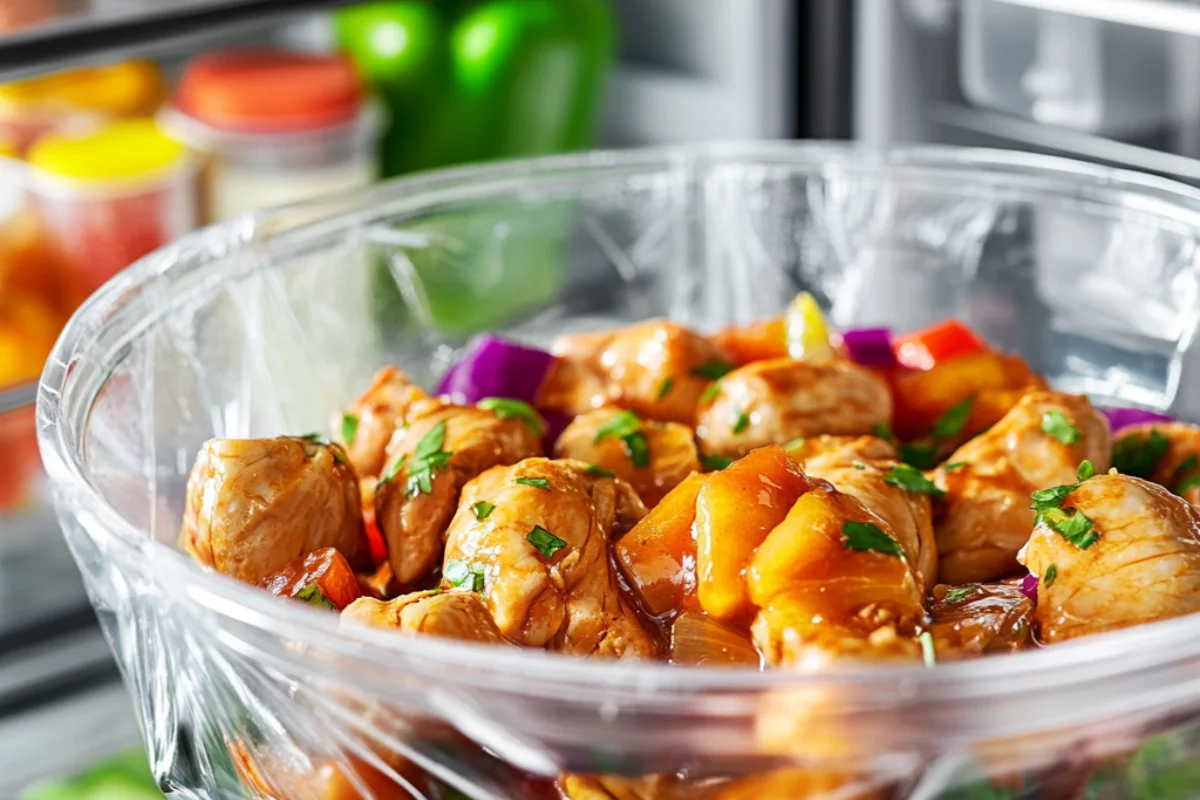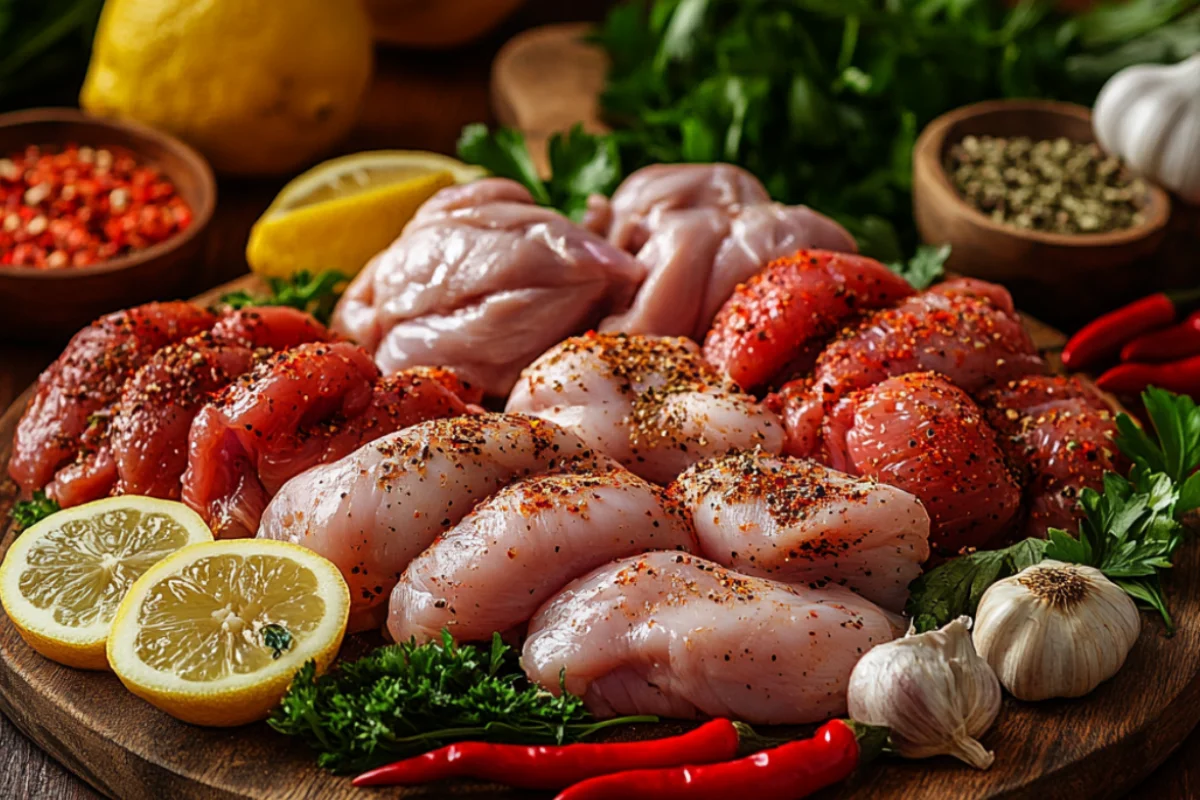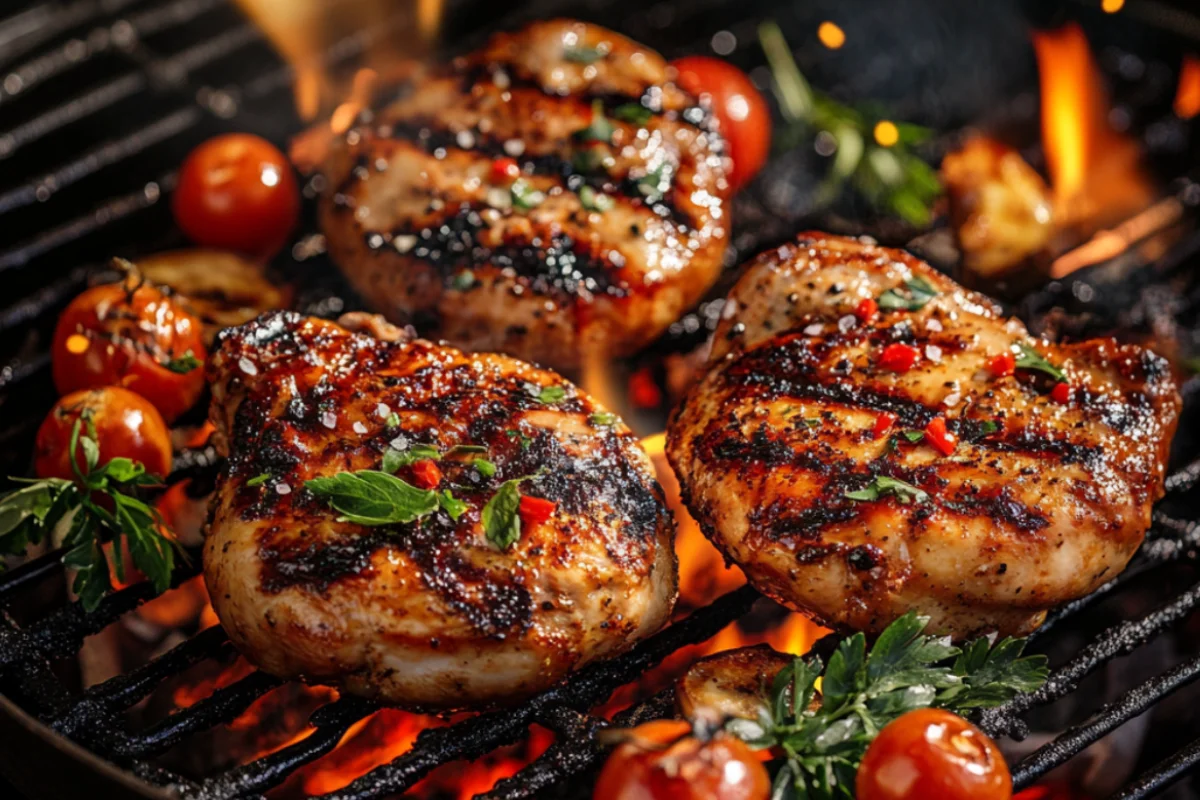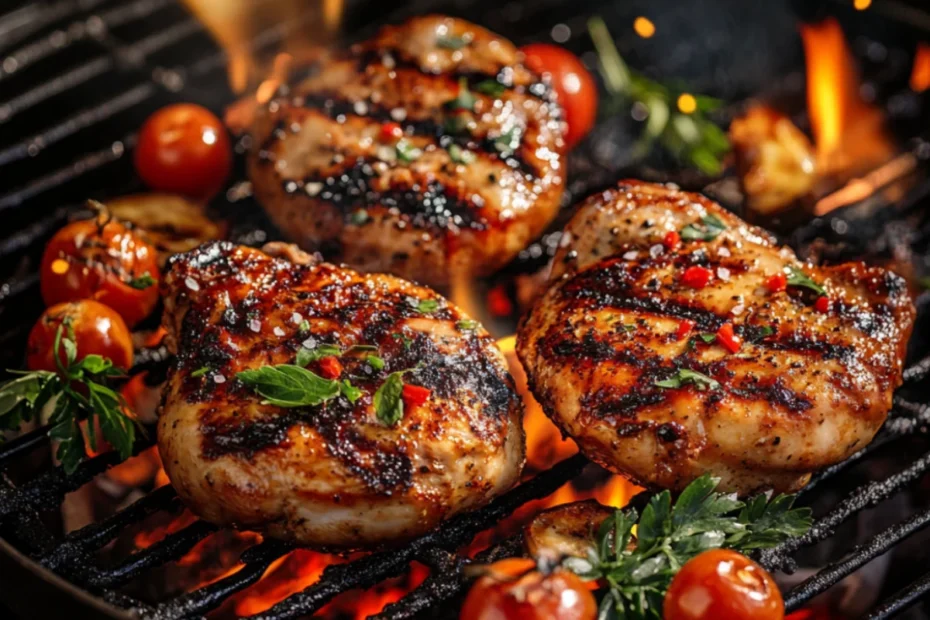Understanding Marination: Mastering the Art of Flavorful Chicken
Marination is an Necessary cuisine technique that Changes chicken into a tender, Savory masterpiece. In this guide, we’ll explore the science, benefits, and techniques of marination, and bust common myths to help you perfect your marination game.
H1: The Science Behind Marination
H2: What is Marination?
Marination refers to soaking food, Usually meat, in a Veteran liquid or mixture to enhance its flavor, texture, and aroma. For chicken, marinades typically include a combination of acids, oils, and spices, working together to break down proteins, add depth, and prepare the meat for cooking.
Key Characteristics of marination:
- Enhances the overall flavor profile.
- Softens and tenderizes the meat.
- Helps create a protective layer, locking in moisture during cooking.
H3: Role of Acids, Oils, and Spices in Marination
The ingredients in a marinade have specific roles:
- Acids like vinegar, lemon juice, or yogurt break down proteins, making the chicken tender.
- Oils act as carriers for fat soluble flavors and prevent the chicken from drying out.
- Spices and aromatics provide distinct tastes and aromas, creating layers of flavor.
This chemical interplay ensures a balance of flavor penetration and Improve look and feel, key to perfect marination.
H3: How Marination Affects Chicken Meat Texture and Flavor
When acids Communicate with the chicken’s protein, they unravel and Soften the fibers, leading to a juicy texture. Simultaneously, the oils help seal the meat’s surface, Keeping Dampness and Boosting Abundance. Spices and herbs seep into these soften fibers, creating a flavorful, Fragrant profile.
H1: Factors Influencing Marination Time
H2: Type of Chicken Cut (Breast, Thighs, Drumsticks, Wings)
Different chicken cuts require varying marination times:
- Breasts: Lean and delicate, they need shorter marination times (1–2 hours).
- Thighs and Drumsticks: Their denser muscle structure benefits from longer marination (4–6 hours).
- Wings: Small and porous, wings absorb marinades quickly (30 minutes–2 hours).
H3: Skin-On vs. Skinless Chicken
- Skin-on chicken acts as a barrier, slowing the marinade’s penetration. Score the skin or marinate longer to achieve flavor depth.
- Skinless chicken absorbs the marinade faster, making it ideal for quick preparations.
H3: Desired Flavor Intensity
For a mild flavor, a short marination time is sufficient. Strong, bold flavors need longer marination to permeate the meat thoroughly.
H1: Common Ingredients for Chicken Marinades
H2: Acidic Bases (Lemon, Vinegar, Yogurt)
Acids form the backbone of a marinade:
- Lemon and vinegar provide a sharp tanginess and aid in tenderization.
- Yogurt adds creaminess, mild acidity, and an extra layer of richness.
H3: Aromatics (Garlic, Onion, Herbs)
Fresh and dried aromatics are flavor enhancers:
- Garlic, onion, and herbs like rosemary, thyme, and cilantro give depth and complexity to the marinade.
- Combined with spices like paprika or cumin, they create regionally inspired profiles.
H3: Oils and Their Effects
Oils, such as olive, sesame, or vegetable oil:
- Help distribute the marinade evenly.
- Carry fat-soluble flavors like chili oil or herb-infused oils.
- Prevent chicken from sticking during cooking.
H1: Benefits of Marination
H2: Enhancing Flavor
Marination infuses chicken with bold and nuanced flavors, turning it into a culinary delight. The interaction of acids, oils, and spices creates taste layers that plain seasoning cannot achieve.
H3: Tenderizing the Meat
By breaking down proteins, marinades ensure softer, more succulent chicken, even when grilled or fried at high temperatures.
H3: Reducing Cooking Time
Pre-softened chicken cooks faster, making marination a time-saver for busy cooks.
H1: Risks of Over-Marinating Chicken
H2: Acid Denaturing Proteins
Overexposure to acidic marinades can denature proteins excessively, causing the chicken to lose its natural structure.
H3: Mushy Texture
Leaving chicken in a marinade for too long, especially acidic ones, can result in a mushy, unappetizing texture.
H3: Loss of Original Chicken Flavor
Excessive marination can overpower the natural taste of chicken, masking its inherent flavors.
H1: Safe Practices for Marinating Chicken

H2: Temperature Control During Marination
Always marinate chicken in the refrigerator to prevent bacterial growth. Keep the temperature below 40°F (4°C).
H3: Proper Containers for Marination
Use non-reactive containers like glass or stainless steel to avoid chemical reactions with acidic ingredients. Sealable bags are also great for even distribution.
H3: Food Safety Guidelines
- Discard leftover marinades that have been in contact with raw chicken.
- Avoid cross-contamination by using separate utensils for raw and cooked meat.
H1: Popular Marination Methods for Chicken
H2: Dry Rubs vs. Wet Marinades
- Dry rubs consist of spices and herbs, creating a crust when cooked.
- Wet marinades include liquids, ideal for deep flavor infusion and tenderizing.
H3: Vacuum Sealing for Faster Marination
Vacuum-sealing chicken with a marinade accelerates the flavor infusion process by removing air, creating stronger contact between the chicken and marinade.
H3: Injecting Marinades into Chicken
For a concentrated flavor boost, inject marinades directly into the meat. This method is ideal for whole chickens.
H1: Cultural Variations in Chicken Marination
H2: Indian Tandoori-Style Marination
Tandoori chicken uses yogurt, turmeric, cumin, and chili for a rich, spicy, and tangy flavor profile.
H3: Mediterranean Herbed Chicken Marinades
Mediterranean marinades include olive oil, lemon, garlic, and herbs like oregano and rosemary for a light, fresh taste.
H3: Asian Soy-Based Marinades
Soy sauce, ginger, garlic, and sesame oil create sweet, salty, and umami-rich Asian-inspired marinades.
H1: Quick vs. Overnight Marination
H2: When Quick Marination Suffices
Short marination times are suitable for lean cuts like chicken breasts or when using intense flavors.
H3: Situations for Overnight Marination
Thicker cuts like thighs or whole chickens benefit from overnight marination for even flavor penetration.
H3: Techniques for Speeding Up Marination
- Use vacuum-sealed bags.
- Score the chicken’s surface for faster absorption.
H1: Common Myths About Chicken Marination
H2: More Time Always Equals Better Flavor
False! Over-marinating can lead to mushy chicken and overly dominant flavors.
H3: All Cuts of Chicken Require the Same Marination Time
Each cut has a unique texture and density, requiring tailored marination times for optimal results.
Ideal Marination Times for Chicken: A Comprehensive Guide
Achieving the perfect marinated chicken Includes understanding the ideal times for different cuts, types of marinades, and cooking methods. Let’s dive into the nuances to elevate your marination skills.
H1: Ideal Times Based on Chicken Cuts

H2: Whole Chicken
Marinating a whole chicken requires more time to ensure the flavors penetrate deep into the meat.
- Ideal time: 12–24 hours.
- Longer marination ensures the interior absorbs the flavors, making it perfect for roasting or grilling.
H3: Chicken Breasts
Chicken breasts are lean and porous, making them ideal for shorter marination:
- Ideal time: 1–2 hours for acidic marinades; up to 6 hours for yogurt based or mild marinades.
- Over-marinating can cause the breast meat to become mushy due to its delicate texture.
H3: Chicken Thighs
Chicken thighs, with their higher fat content and dense texture, benefit from longer marination:
- Ideal time: 4–6 hours.
- For deeper flavor, an overnight marination (up to 12 hours) is ideal, especially with yogurt or spice heavy marinades.
H3: Wings and Drumsticks
Smaller cuts like wings and drumsticks absorb marinades quickly:
- Ideal time: 30 minutes to 2 hours.
- These cuts are great for quick grilling or frying after a short marination.
H1: Marination Time Based on Marinade Type
H2: Acidic Marinades (1-6 Hours)
Acidic marinades with ingredients like lemon, vinegar, or wine are powerful tenderizers but need careful timing:
- Over-marinating (beyond 6 hours) can lead to a mushy texture.
H3: Yogurt-Based Marinades (6-12 Hours)
Yogurt-based marinades work more gently:
- Their natural acidity tenderizes without compromising texture, making them ideal for overnight marination.
H3: Dry Rub Marinades (Up to 24 Hours)
Dry rubs are versatile and can be left on chicken longer:
- Ideal time: 2–24 hours.
- They form a crust during cooking, locking in flavor and moisture.
H1: Adjusting Marination Time for Cooking Method

H2: Grilling
Grilled chicken benefits from longer marination:
- Recommended time: 4–12 hours.
- The direct heat caramelizes the marinade, enhancing smoky flavors.
H3: Baking or Roasting
For oven cooking:
- Recommended time: 6–24 hours for whole chickens or thighs.
- This ensures even flavor distribution throughout the chicken.
H3: Frying
Frying requires shorter marination times to prevent burning:
- Recommended time: 1–2 hours for breasts and wings.
H3: Slow Cooking or Sous Vide
With slow cooking methods, marination times can be shorter since the extended cooking compensates:
- Recommended time: 2–6 hours.
H1: Quick Marination Hacks
H2: Using Marinades with Higher Salt Content
Salt speeds up flavor absorption by breaking down proteins faster:
- Opt for soy sauce or brine-heavy marinades for quick results.
H3: Massaging the Marinade into the Chicken
Gently massaging the marinade ensures even coating:
- This helps ingredients penetrate faster, especially for quick marination.
H3: Cutting Chicken into Smaller Pieces
Smaller chicken pieces absorb flavors more quickly:
- For stir-fries or skewers, cut the chicken into bite-sized chunks to marinate in as little as 30 minutes.
H1: Indicators of Properly Marinated Chicken
H2: Surface Texture Changes
Properly marinated chicken feels slightly firmer:
- This is due to the protein interaction with acids or salts in the marinade.
H3: Color Penetration in the Meat
Look for a uniform change in color:
- For example, turmeric-based marinades give chicken a golden hue, while soy-based marinades create a rich brown exterior.
H3: Aroma of the Marinade
Well-marinated chicken has a distinct, pleasant aroma:
- The spices, herbs, or acidic components should blend harmoniously.
H1: Effects of Over and Under Marination
H2: Overpowering Marinade Flavors
Over-marinating can overshadow the natural chicken flavor:
- Strong acidic or spice-heavy marinades can become dominant.
H3: Lack of Flavor Penetration
Under-marinating results in surface-level seasoning:
- Ensure the chicken is marinated long enough for balanced flavor.
H3: Tough or Chewy Texture
Acidic marinades used for too long can make the meat overly soft or tough:
- Stick to recommended times to avoid undesirable textures.
H1: Comparing Homemade and Store-Bought Marinades
H2: Benefits of DIY Marinades
Homemade marinades offer:
- Full control over ingredients, catering to dietary preferences.
- No preservatives or artificial flavors.
H3: Time Efficiency of Pre-Made Options
Store-bought marinades are convenient:
- Ideal for quick meals or last-minute cooking.
H3: Cost and Flavor Differences
DIY marinades are cost-effective and customizable:
- Store-bought options may lack the freshness and vibrancy of homemade blends.
H1: Recommended Tools for Marination
H2: Ziplock Bags and Airtight Containers
Ziplock bags:
- Ensure even coating and require less marinade.
Airtight containers:
- Prevent spills and maintain freshness.
H3: Glass Bowls vs. Plastic
Glass bowls are non reactive:
- Perfect for acidic marinades, while plastic may absorb odors.
H3: Using Marinade Injectors
Marinade Syringes ensure:
- Flavor penetrates deep into the meat, perfect for whole chickens or thick cuts.
H1: Marination for Special Diets
H2: Gluten-Free Marinade Options
For gluten free diets:
- Use tamari or coconut aminos as substitutes for soy sauce.
H3: Low-Sodium Marinades
Low-sodium options:
- Include fresh herbs, citrus, and garlic for flavor without relying on salt.
H3: Keto-Friendly Marinades
For keto diets:
- Use full-fat yogurt, oils, and keto-friendly spices like paprika and cumin.
H1: FAQs on Marinating Chicken
H2: Can Chicken Be Marinated Too Long?
Yes. Over-marinating, especially in acidic bases, can result in mushy chicken.
H3: Should Chicken Be Marinated at Room Temperature?
No. Always marinate chicken in the refrigerator to prevent bacterial growth.
H3: How to Store Marinated Chicken?
Store marinated chicken in:
- Airtight containers or sealed bags in the fridge for up to 24 hours.
Tips and Tricks for Perfect Marination: Unlocking Ultimate Flavor
Mastering the art of marination requires a blend of preparation, Ingenuity, and technique. This guide dives into necessary tips and tricks to ensure your marinated chicken is always Delicious, tender, and a cuisine delight.
H1: Preparing Chicken for Marination
H2: Cleaning and Trimming Chicken
Proper preparation starts with clean, trimmed chicken:
- Rinse chicken under cold water to remove surface debris.
- Pat dry to avoid excess moisture diluting the marinade.
- Trim excess fat and sinew for even marination and cooking.
H3: Puncturing or Scoring the Chicken
Scoring or Piercing chicken helps marinades penetrate deeper:
- Scoring: Use a sharp knife to create shallow cuts on the surface.
- Puncturing: Use a fork to create tiny holes, especially for thicker cuts like thighs or drumsticks.
H3: Drying Chicken Before Applying Marinade
Dry chicken absorbs marinades better:
- Use paper towels to blot the chicken until no visible moisture remains.
- A dry surface ensures the marinade sticks evenly.
H1: Experimenting with Marinade Recipes
H2: Sweet and Spicy Marinades
Create bold flavor combinations with sweet and spicy notes:
- Combine honey or brown sugar with chili flakes, cayenne pepper, or sriracha.
- Perfect for barbecue wings or grilled Legs.
H3: Herbal and Citrus-Infused Marinades
Herbs and citrus create fresh, Fragrant blends:
- Use lemon, lime, or orange juice paired with Herb of remembrance, thyme, or mint.
- Ideal for summer grilling or light roasts.
H3: Savory and Umami-Rich Options
For deep, savory flavors:
- Combine soy sauce, Worcestershire, miso paste, or fish sauce with garlic and ginger.
- These marinades excel in stir fries and Asian-inspired dishes.
H1: Balancing Marinade Ingredients
H2: Ratios of Acids, Oils, and Spices
A Equilibrated marinade ensures even flavor:
- Use a 3:1 ratio of oil to acid for creamy and stable emulsions.
- Adjust spice intensity based on your preferred flavor profile.
H3: Adding Sugar for Caramelization
Incorporating sugar or natural sweeteners promotes caramelization:
- Ingredients like honey, maple syrup, or molasses enhance browning during grilling or roasting.
H3: Avoiding Overpowering Flavors
Balance is key to marination success:
- Avoid excess vinegar or soy sauce, which can dominate other ingredients.
- Taste your marinade before applying it to adjust seasoning.
H1: Layering Flavors in Marination
H2: Marinating in Stages
Layer flavors by marinating in stages:
- Start with a base marinade, then add specific spices or oils closer to cooking time forIncreased intricacy.
H3: Adding Fresh Herbs and Garnishes Post-Marination
Fresh herbs, lemon zest, or grated garlic added just before cooking:
- Brighten flavors without Agreeing the marinade’s depth.
H3: Combining Marinades for Complex Flavors
Mixing Harmonizing marinades creates multi Structural flavors:
- For example, start with a yogurt marinade and finish with a soy glaze.
H1: Making the Most of Leftover Marinades
H2: Using as Basting Sauces
Reserve a portion of the marinade for basting:
- Apply during cooking to enhance moisture and flavor.
H3: Reducing into Glazes
Leftover marinades can be reduced on the stove:
- Simmer until thickened to create a sticky glaze for final garnishing.
H3: Transforming into Dipping Sauces
Transform extra marinade into a sauce:
- Boil Completely to kill Microbes, then adjust spices for dipping.
H1: Seasonal and Regional Variations in Marination
H2: Winter Spice Blends
Winter marinades use warm spices:
- Combine cinnamon, nutmeg, allspice, and clove with molasses for holiday inspired flavors.
H3: Summer Citrus Marinades
Citrus-based marinades are ideal for summer:
- Pair orange juice, lemon zest, and fresh herbs for light, Revitalizing chicken.
H3: Festive Holiday-Inspired Flavors
For festive occasions:
- Incorporate cranberry juice, sage, or Nar ekşisi into marinades.
H1: Troubleshooting Common Marination Issues
H2: Chicken Not Absorbing Marinade
If the chicken isn’t Assimilating marinade:
- Ensure it’s scored or Pierced.
- Use a vacuum sealer to enhance Assimilation.
H3: Uneven Marination
Prevent uneven coating:
- Massage the marinade into the chicken and turn it occasionally.
H3: Overpowering Acidity
Balance acidic marinades with Honey:
- Add honey or sugar to mellow vinegar or citrus heavy blends.
H1: Optimizing Flavor Absorption
H2: Temperature Effects on Marination
Marinate chicken in the store cold:
- Cold temperatures slow Microbial growth while Permitting flavors to develop.
H3: Timing the Marinade Application
Apply marinades Tactically:
- Shorter times for lean cuts, longer for fattier cuts or whole chicken.
H3: Resting Marinated Chicken Before Cooking
Let marinated chicken rest at room temperature for 15–30 minutes:
- This ensures even cooking and helps bring out flavors.
H1: Advanced Techniques for Marinating Chicken
H2: Sous Vide Marination
Sous vide Unites marination and cooking:
- Seal chicken with the marinade and cook at a precise temperature for Unparalleled texture.
H3: Marinating Under Pressure
Use vacuum sealing or pressure tools:
- Speeds up marination by forcing the marinade into the chicken.
H3: Smoking Marinades for Added Depth
Add smoky elements:
- Incorporate liquid smoke or use smoked paprika for unique, rich flavors.
H1: Best Practices for Marination Storage
H2: Freezing Marinated Chicken
Freeze chicken in the marinade for later use:
- It Improves flavor as the chicken thaws.
H3: Thawing and Cooking Pre-Marinated Chicken
Thaw marinated chicken in the fridge:
- Avoid room temperature thawing to maintain safety and flavor.
H3: Avoiding Cross-Contamination
Use separate Implements and packages for raw chicken:
- Discard Remnants marinades that touched raw meat unless Completely cooked.
FAQs on Perfect Marination
- How long can chicken be marinated? Up to 24 hours for most marinades, Relying on spices.
- Can you reuse marinades? Only if boiled to kill Microbes from raw chicken.
- What’s the best Packages for marination? Non-reactive Packages like glass or Reclosable bags.

